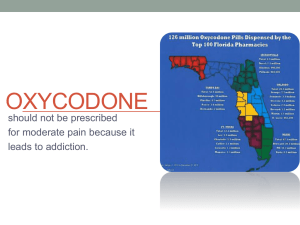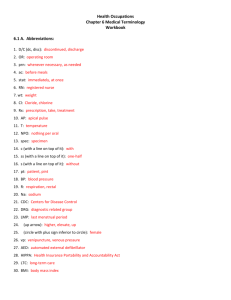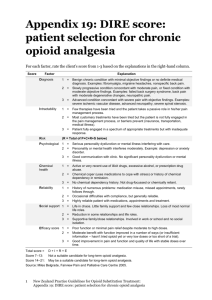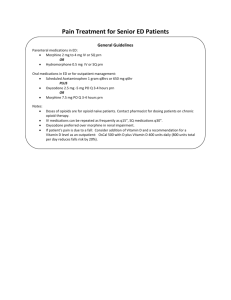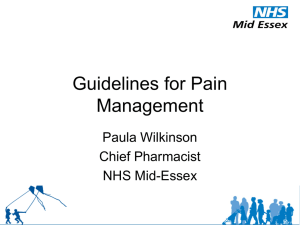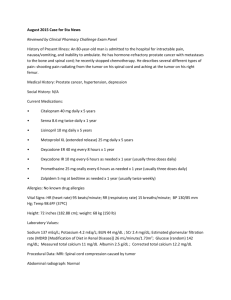- Journal of Pain, The
advertisement
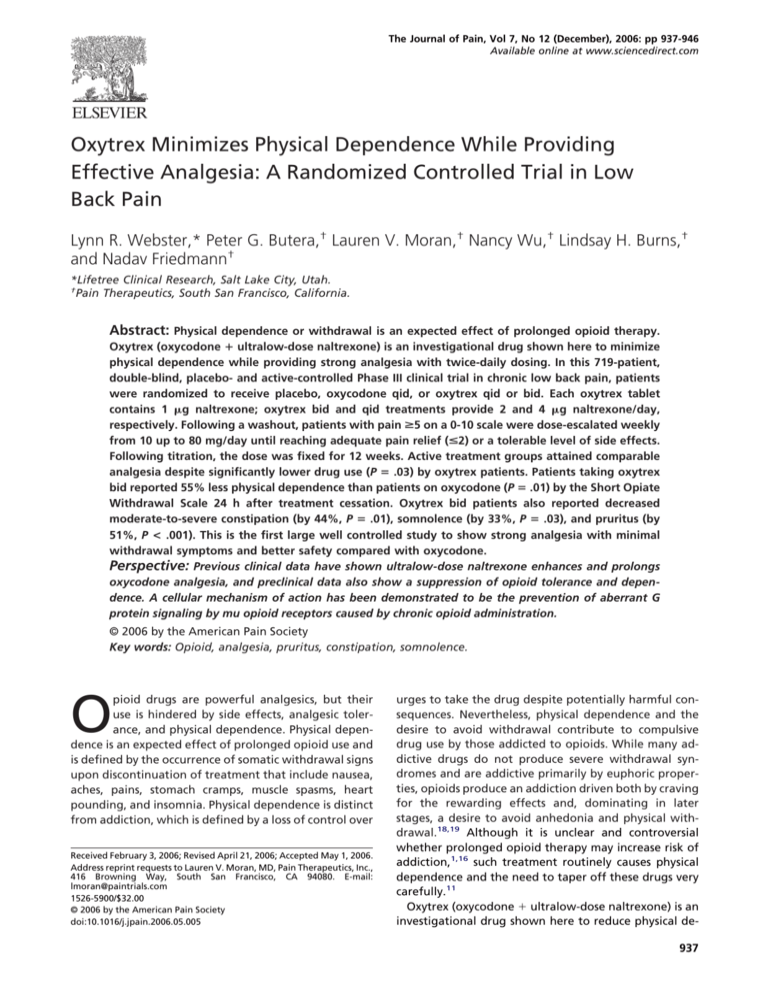
The Journal of Pain, Vol 7, No 12 (December), 2006: pp 937-946 Available online at www.sciencedirect.com Oxytrex Minimizes Physical Dependence While Providing Effective Analgesia: A Randomized Controlled Trial in Low Back Pain Lynn R. Webster,* Peter G. Butera,† Lauren V. Moran,† Nancy Wu,† Lindsay H. Burns,† and Nadav Friedmann† *Lifetree Clinical Research, Salt Lake City, Utah. † Pain Therapeutics, South San Francisco, California. Abstract: Physical dependence or withdrawal is an expected effect of prolonged opioid therapy. Oxytrex (oxycodone ⴙ ultralow-dose naltrexone) is an investigational drug shown here to minimize physical dependence while providing strong analgesia with twice-daily dosing. In this 719-patient, double-blind, placebo- and active-controlled Phase III clinical trial in chronic low back pain, patients were randomized to receive placebo, oxycodone qid, or oxytrex qid or bid. Each oxytrex tablet contains 1 g naltrexone; oxytrex bid and qid treatments provide 2 and 4 g naltrexone/day, respectively. Following a washout, patients with pain >5 on a 0-10 scale were dose-escalated weekly from 10 up to 80 mg/day until reaching adequate pain relief (<2) or a tolerable level of side effects. Following titration, the dose was fixed for 12 weeks. Active treatment groups attained comparable analgesia despite significantly lower drug use (P ⴝ .03) by oxytrex patients. Patients taking oxytrex bid reported 55% less physical dependence than patients on oxycodone (P ⴝ .01) by the Short Opiate Withdrawal Scale 24 h after treatment cessation. Oxytrex bid patients also reported decreased moderate-to-severe constipation (by 44%, P ⴝ .01), somnolence (by 33%, P ⴝ .03), and pruritus (by 51%, P < .001). This is the first large well controlled study to show strong analgesia with minimal withdrawal symptoms and better safety compared with oxycodone. Perspective: Previous clinical data have shown ultralow-dose naltrexone enhances and prolongs oxycodone analgesia, and preclinical data also show a suppression of opioid tolerance and dependence. A cellular mechanism of action has been demonstrated to be the prevention of aberrant G protein signaling by mu opioid receptors caused by chronic opioid administration. © 2006 by the American Pain Society Key words: Opioid, analgesia, pruritus, constipation, somnolence. O pioid drugs are powerful analgesics, but their use is hindered by side effects, analgesic tolerance, and physical dependence. Physical dependence is an expected effect of prolonged opioid use and is defined by the occurrence of somatic withdrawal signs upon discontinuation of treatment that include nausea, aches, pains, stomach cramps, muscle spasms, heart pounding, and insomnia. Physical dependence is distinct from addiction, which is defined by a loss of control over Received February 3, 2006; Revised April 21, 2006; Accepted May 1, 2006. Address reprint requests to Lauren V. Moran, MD, Pain Therapeutics, Inc., 416 Browning Way, South San Francisco, CA 94080. E-mail: lmoran@paintrials.com 1526-5900/$32.00 © 2006 by the American Pain Society doi:10.1016/j.jpain.2006.05.005 urges to take the drug despite potentially harmful consequences. Nevertheless, physical dependence and the desire to avoid withdrawal contribute to compulsive drug use by those addicted to opioids. While many addictive drugs do not produce severe withdrawal syndromes and are addictive primarily by euphoric properties, opioids produce an addiction driven both by craving for the rewarding effects and, dominating in later stages, a desire to avoid anhedonia and physical withdrawal.18,19 Although it is unclear and controversial whether prolonged opioid therapy may increase risk of addiction,1,16 such treatment routinely causes physical dependence and the need to taper off these drugs very carefully.11 Oxytrex (oxycodone ⫹ ultralow-dose naltrexone) is an investigational drug shown here to reduce physical de937 938 pendence compared with oxycodone alone. The present randomized double-blind placebo- and active-controlled phase III clinical trial compared oxytrex with oxycodone alone in patients with moderate-to-severe chronic low back pain. Low back pain may be acute or chronic and can be caused by a variety of diseases or disorders affecting the lumbar spine, including musculoligamentous injuries, age-related degeneration in the disks and facet joints, disk herniation, and spinal stenosis.9 Previous preclinical and clinical reports have shown that a variety of ultralow-dose opioid antagonists paradoxically enhance and prolong opioid analgesia.4,5,7,15,17,24,26,27 Extensive preclinical data have also shown ultralow-dose opioid antagonists to attenuate opioid analgesic tolerance and withdrawal effects.5,21–24,26,27 Preclinical studies have shown that within an “ultralow” dose range of pg/kg to g/kg, lower doses of opioid antagonists are more effective than higher doses in enhancing analgesia and reducing tolerance and dependence.24,25 Clinical reports that have demonstrated enhanced analgesia4,7,15,17 or reduced drug use by patient-controlled analgesia12 have used far lower opioid antagonist doses than the clinical studies that failed to demonstrate beneficial effects of low doses of opioid antagonists.2,3 In addition, in a pharmacokinetic analysis in a subset of patients in a phase II clinical trial of oxytrex, analgesic efficacy negatively correlated with plasma 6-naltrexol, the major metabolite of naltrexone, ie, the lower the plasma concentration of 6-naltrexol, the greater the analgesia.4,8 In the previous phase II clinical trial, equivalent total daily oxycodone doses between active treatments demonstrated that the oxytrex bid treatment, incorporating 2 g/day naltrexone, produced significantly greater pain relief than both oxycodone qid and oxytrex qid, which included 4 g/day naltrexone (P ⬍ .01 for both comparisons).4 Moreover, that trial demonstrated the effectiveness of the oxytrex treatment containing the lower naltrexone dose as well as its less frequent dosing. In this phase III trial, patients received placebo, oxycodone qid, oxytrex qid, or oxytrex bid and gradually titrated their daily dose to a pain score of ⱕ2, to a tolerable level of side effects, or to a maximum of 80 mg/day. Patients then remained on their individual fixed doses for 12 weeks. Treatment was abruptly discontinued at the end of the study so that withdrawal could be assessed. This design allowed comparison of oxytrex with oxycodone in the dose needed for maximal pain relief, side effects, and the extent of physical dependence and tolerance developing over the 3-month treatment. Methods Patients This trial was conducted between May 2003 and December 2004 at 45 U.S. sites. Patients between the ages of 18 and 70 with persistent low back pain for at least 6 months requiring daily analgesics were enrolled in the study. To be eligible, patients had to have a baseline pain Low-Dose Naltrexone Reduces Oxycodone Dependence intensity (PI) score ⱖ5 at the screening visit, a mean daily PI score ⱖ5 recorded in a diary over the last 3 days of a 4-10 day washout period while off all analgesics except acetaminophen, and a confirmatory PI score ⱖ5 at the baseline visit at the conclusion of the washout period. Patients taking a daily opioid dose equivalent to ⬎20 mg of oxycodone required a taper, and a 72-h period of no opioid medication before screening was required of all patients. Patients were excluded for low back pain that was secondary to malignancy, autoimmune disease, fibromyalgia, recent fracture, or infection. Patients were also excluded for positive urine drug screens for any illicit substance at baseline, a history of substance abuse within 5 years, or involvement in litigation regarding their lower back condition. Further exclusion criteria included: pregnancy; known hypersensitivity to any of study medications; severe hepatic, pulmonary, or renal impairment; unstable cardiac disease, active malignancy, or history of leukemia, lymphoma, or metastatic cancer; investigational drug use; corticosteroid therapy; intraspinal analgesic infusion or spinal cord stimulator in the preceding month; major surgery in the preceding 3 months; percutaneous or open procedure of the lumbosacral spine in the preceding 4 months; or high doses of central nervous system depressants or phenothiazines. Tricyclic antidepressants, selective serotonin reuptake inhibitors, glucosamine/chrondroitin, or St. John’s wort were allowed if doses were stable for 4 weeks before study entry. This study was approved by the Institutional Review Board of each site, and informed consent was obtained from all study participants. The informed consent form clearly stated that one of the objectives of the study was to compare opioid withdrawal symptoms after abrupt study drug discontinuation, and patients were educated about the symptoms of opioid withdrawal. Treatment Procedures This study was a randomized, double-blind, multicenter, and placebo- and active-controlled trial. After an initial screening visit, eligible patients entered a 4-10 day washout of all analgesics except acetaminophen. At the end of the washout, qualifying patients were randomized via a central call-in system to 1 of 4 treatments in a 1:2:2:2 ratio of placebo, oxycodone qid, oxytrex qid, or oxytrex bid. Randomization was stratified by gender. All patients in active treatment groups started at a total daily oxycodone dose of 10 mg/day (divided bid or qid). No other analgesics were allowed during the treatment period. Over 1-6 weeks, patients titrated their daily dose to a pain score ⱕ2, until a tolerable level of side effects were experienced, or to a maximum of 80 mg/day. Dose titration occurred at weekly visits as follows: 10 mg/day, 20 mg/day, 30 mg/day, 40 mg/day, 60 mg/day, and 80 mg/day. One dose reduction was allowed if unacceptable side effects occurred. Patients were blinded to treatment group but not to dose. Table 1 depicts the dose escalations at the end of each week of titration for patients with inadequate pain relief. Following the titration period, patients remained on their final dose for 12 weeks. ORIGINAL REPORT/Webster et al Table 1. WEEK 1 2 3 4 5 6 939 Dose Titration TOTAL DAILY OXY DOSE 10 mg 20 mg 30 mg 40 mg 60 mg 80 mg PLACEBO 0 0 0 0 0 0 QID OXY QID 2.5 mg 5 mg 7.5 mg 10 mg 15 mg 20 mg OXYTREX QID OXY 2.5 mg ⫹ NTX .001 mg OXY 5 mg ⫹ NTX .001 mg OXY 7.5 mg ⫹ NTX .001 mg OXY 10 mg ⫹ NTX .001 mg OXY 15 mg ⫹ NTX .001 mg OXY 20 mg ⫹ NTX .001 mg OXYTREX BID OXY 5 mg ⫹ NTX .001 mg OXY 10 mg ⫹ NTX .001 mg OXY 15 mg ⫹ NTX .001 mg OXY 20 mg ⫹ NTX .001 mg OXY 30 mg ⫹ NTX .001 mg OXY 40 mg ⫹ NTX .001 mg Abbreviations: OXY, oxycodone; NTX, naltrexone. Besides the dosing regimen, oxytrex bid differed from oxytrex qid by the total daily dose of naltrexone: Each active dose contained 1 g naltrexone, so that the oxytrex bid group received 2 g/day and the oxytrex qid received 4 g/day. All study medications were identical in appearance, and patients, site personnel, and study monitors were blinded to treatment assignments. Study drug was administered in blister packets with four pills allotted per day; two placebo pills alternated with oxytrex tablets for the oxytrex bid treatment group to maintain blinding. Clinic visits were performed weekly during titration and the first 2 weeks of the fixed dose period, then biweekly for the remainder of the treatment period. During the clinic visit conducted on the last day of dosing, patients were educated about symptoms of opioid withdrawal and were instructed to return to the site immediately for treatment if severe or intolerable symptoms were experienced; investigators treated opioid withdrawal with an opioid taper, clonidine, and/or symptomatic treatment as appropriate. Site personnel called patients daily for the first 4 days after study discontinuation to monitor for opioid withdrawal or other adverse events. severe): constipation, somnolence, nausea, vomiting, dizziness, and pruritus. In addition, adverse events spontaneously reported by patients or observed by the investigators were recorded at each visit. Clinical laboratory evaluations (hematology, chemistry, urinalysis, and electrocardiography) were collected at baseline and at the end of treatment. Opioid toxicity and vital signs were assessed at clinic visits to assure that each patient was not experiencing serious toxicity. Before discontinuing treatment, all patients who had taken study drug for ⱖ4 weeks were to complete the Short Opiate Withdrawal Scale (SOWS)14 on their last day of treatment for a baseline measure and subsequently on days 1, 2, 3, and 4 after discontinuation of treatment. Patients rated the severity of 10 symptoms (feeling sick, stomach cramps, muscle spasms/twitching, feelings of coldness, heart pounding, muscular tension, aches/pains, yawning, runny eyes, and insomnia/problems sleeping) on a scale of 0-3 (0 ⫽ none, 1 ⫽ mild, 2 ⫽ moderate, 3 ⫽ severe). The SOWS scores were calculated by summing the 10 symptom scores (for a range of 0 to 30 points) and subtracting each patient’s baseline. Outcome Measures The planned sample size was 100 patients in the placebo group and 200 patients in each of the 3 active treatment groups. The sample size of 700 patients was required to detect a clinically meaningful difference between treatment groups of 10% in PI from baseline to the end of treatment. A 10% difference was chosen because of the high placebo response usually seen in pain trials as well as the expectation of regression toward the mean when cutoff baseline PI levels are used as entry criteria. Because clinical trials of patients with chronic low back pain and of opioid medications typically have high drop-out rates, the drop-out rate was estimated at 40% for sample size calculation. The primary efficacy measure used was the 11-point numerical diary Pain Intensity Scale. Patients were asked to record a numerical score at bedtime each day for the overall pain intensity during the past 24 hours (0 ⫽ no pain and 10 ⫽ severe pain). Secondary efficacy measures included the Short-Form 12-Question Health Survey (SF12)13 and the Oswestry Disability Index (ODI) for low back pain,10 which were collected at baseline, monthly, and at the end of treatment. Other secondary efficacy assessments, conducted at each clinic visit, included: the Quality of Analgesia, for which patients rated pain relief as “poor,” “fair,” “good,” “very good,” or “excellent,” and the Global Assessment of Study Drug, for which patients gave an overall rating as “poor,” “fair,” “good,” “very good,” or “excellent,” taking into consideration the quality of pain relief, side effects, activity level, mood, and sense of well-being in this evaluation. Patients were to complete daily ratings in their diaries of the following 6 opioid-related adverse events on a scale of 0 to 3 (0 ⫽ none, 1 ⫽ mild, 2 ⫽ moderate, 3 ⫽ Sample Size Statistical Methods The primary analysis population for both efficacy and safety included the intent-to-treat population consisting of all randomized patients who took at least one dose of study medication and had at least one post-baseline PI assessment. The primary efficacy variable was the percentage change in baseline PI scores to the end of the 940 Table 2. Low-Dose Naltrexone Reduces Oxycodone Dependence Demographics PLACEBO (N ⫽ 101) Age (yrs) Gender Male Female Opioid use in preceding month Yes No High-dose opioids* Height (cm) Weight (kg) OXYCODONE QID (N ⫽ 206) OXYTREX QID (N ⫽ 206) OXYTREX BID (N ⫽ 206) 48.7 47.9 47.8 47.9 39 (38.6%) 62 (61.4%) 80 (38.8%) 126 (61.2%) 79 (38.3%) 127 (61.7%) 79 (38.3%) 127 (61.7%) 43 (42.6%) 58 (57.4%) 5 (5.0%) 169.1 84.4 99 (48.1%) 107 (51.9%) 10 (4.9%) 169.0 85.4 85 (41.3%) 121 (58.7%) 15 (7.3%) 169.5 90.1 88 (42.7%) 118 (57.3%) 13 (6.3%) 169.2 85.6 *Patients on high-dose opioids during preceding month defined as ⱖ20 mg oxycodone/day (or equivalent). fixed-dose period. Baseline scores were the mean of the last 3 days of washout, and the end-of-treatment scores were the mean of the last 3 days of the treatment period. The primary comparison of interest was the oxycodone qid group versus oxytrex bid. An analysis of covariance (ANCOVA) model including treatment and gender as factors and baseline pain intensity as a covariate was used for global and pair-wise inferences. The primary analysis used the last observation carried forward (LOCF) imputation method for handling missing pain intensity values. An additional analysis was used to validate the LOCF procedure: an average over all treatments, in which a missing PI value was imputed as the mean PI among all patients with the same previous nonmissing value (across all treatment groups). For secondary efficacy analyses, percentage change from baseline values of SF-12 and ODI at the end of treatment was analyzed using ANCOVA models with treatment and gender as effects and baseline score as a covariate. Treatment groups were also compared by total average daily dose using an analysis of variance (ANOVA) model with treatment as the main effect. The global assessment of study medication and quality of analgesia at each week were analyzed using the Cochran-MantelHaenszel row mean scores test using equally spaced scores. Safety analyses included reporting the incidence and severity of adverse events, as well as comparing the frequency of moderate-to-severe opioid-related adverse events by treatment. The frequency of each moderateto-severe opioid-related adverse event and SOWS scores (change from baseline at each day after study drug discontinuation) were analyzed by ANOVA. Results Patients Randomization produced similar treatment groups with respect to demographic and baseline characteristics (Table 2). Of the 719 patients randomized to treatment, 391 patients (54%) did not complete the study, and most of these discontinuations (65%) occurred during the titration period. The primary reason for discontinuation of study drug in active treatment groups was adverse events (22%-31%), predominantly common opioidrelated side effects. Inadequate pain relief was the primary reason for discontinuation in the placebo group (40%). A study flow diagram is presented in Fig 1. Of the 456 patients that continued treatment ⱖ4 weeks and were therefore eligible to complete the SOWS, a minimum of both baseline and day 1 SOWS scores were obtained from 360 patients. Others were noted as “no score reported” in the study flow diagram and were excluded from analysis. Patients included in the SOWS analyses were very similar to randomized patients with respect to demographic and baseline characteristics. The number of patients with SOWS scores on days 1, 2, and 3 remained relatively constant for all treatment groups with no more than 1 patient missing per treatment group. However, compliance with the day 4 SOWS assessment was worse: An additional 3 placebo, 8 oxycodone qid, 8 oxytrex qid, and 9 oxytrex bid patients were missing day 4 SOWS scores. Analgesic Efficacy All active treatment groups separated from placebo. At the end of the treatment period, the percentage reductions in pain scores from baseline were not significantly different among active treatment groups (Table 3). No evidence of analgesic tolerance was seen over this 3-month fixed-dose treatment period: Mean PI scores remained constant between the first and last weeks of the fixed-dose period. As described in the Methods, an additional imputation method was used to validate the LOCF procedure for the analysis of pain intensity scores. This analysis also did not reveal any group differences among active treatments. Oxytrex bid and oxycodone had significantly greater reductions in PI compared with placebo (P ⫽ .025 and P ⫽ .031, respectively) for the average across treatments imputation. Despite comparable analgesia between active treatment groups, the total average daily dose was 12% lower for both oxytrex qid and oxytrex bid, at 34.5 and 34.7 mg, respectively, than for oxycodone patients, who took a total average daily dose of 39.0 mg (P ⫽ .03 for both comparisons). ORIGINAL REPORT/Webster et al 941 1061 Assessed for Eligibility 342 Excluded 215 Not Meeting Inclusion Criteria 62 Refusd to Participate 65 Other Reasons 719 Randomized 101 Assigned to Receive Placebo 206 Assigned to Receive Oxycodone QID 206 Assigned to Receive Oxytrex QID 206 Assigned to Receive Oxytrex BID 59 Discontinued Treatment 40 Inadequate Pain Relief 5 Adverse Events 2 Protocol Violation 6 Patient Request 6 Other 105 Discontinued Treatment 15 Inadequate Pain Relief 49 Adverse Events 3 Protocol Violation 11 Patient Request 27 Other 119 Discontinued Treatment 22 Inadequate Pain Relief 45 Adverse Events 7 Protocol Violation 9 Patient Request 36 Other 108 Discontinued Treatment 19 Inadequate Pain Relief 63 Adverse Events 9 Patient request 17 Other 101 Included in LOCF Analgesia Analysis 205 Included in LOCF Analgesia Analysis 1 Excluded for No PostBaseline PI 199 Included in LOCF Analgesia Analysis 6 Excluded for No PostBaseline PI 204 Included in LOCF Analgesia Analysis 2 Excluded for No PostBaseline PI 67 Eligible for SOWS 57 Included in Analysis 10 No Score Reported 137 Eligible for SOWS 106 Included in Analysis 31 No Score Reported 124 Eligible for SOWS 101 Included in Analysis 23 No Score Reported 128 Eligible for SOWS 96 Included in Analysis 32 No Score Reported Figure 1. Study flow diagram. SOWS, Short Opiate Withdrawal Scale; LOCF, last observation carried forward. Physical Dependence The SOWS scores, indicating severity of withdrawal, were used to assess physical dependence. The mean SOWS score for oxytrex bid the first day after drug discontinuation was significantly reduced from that of oxycodone (P ⫽ .009; Fig 2A), a percentage reduction of 55.8%. In addition, whereas SOWS scores for oxycodone were significantly greater than placebo for the first 3 days after discontinuation (P ⬍ .001 for days 1 and 2, P ⫽ .02 for day 3) with a trend on day 4 (P ⫽ .07), SOWS scores for oxytrex bid were significantly greater than placebo only on day 2 (P ⫽ .01) with trends on day 1 and 3 (P ⫽ .06 and .07, respectively). A subgroup analysis showed a slightly stronger effect in reducing dependence in patients over 50 years of age: Table 3. an 80.1% reduction in day 1 SOWS scores by oxytrex bid compared with oxycodone. In patients over 50, oxytrex bid SOWS scores were significantly reduced on days 1, 2, and 4 (P ⫽ .03 for days 1 and 2, P ⫽ .05 for day 4) with a trend (P ⫽ .08) toward a significant reduction on day 3 compared with oxycodone scores (Fig 2B). In addition, whereas SOWS scores for the oxycodone qid treatment group were significantly greater than placebo SOWS scores on days 1, 2, and 4 (P ⫽ .007, .006, and .02, respectively) with a trend (P ⫽ .07) on day 3, there were no significant differences between the oxytrex bid and placebo treatment groups on all 4 days of the opioid withdrawal monitoring period for patients over 50. Although patients under 50 comprised only 38.2% of the total in this trial, the reductions in SOWS scores on Week 12 Percentage Reduction in Baseline Pain Intensity PLACEBO Baseline pain intensity Week 1 of fixed dose pain intensity Week 12 pain intensity Week 12 percentage change from baseline NOTE. Values are mean ⫾ SD. *P ⬍ .05 compared to placebo. OXYCODONE QID OXYTREX QID OXYTREX BID 7.7 ⫾ 1.44 5.4 ⫾ 2.87 7.6 ⫾ 1.36 3.9 ⫾ 2.53 7.3 ⫾ 1.36 4.1 ⫾ 2.51 7.6 ⫾ 1.33 4.2 ⫾ 2.55 5.2 ⫾ 3.05 4.0 ⫾ 2.53 4.2 ⫾ 2.56 4.3 ⫾ 2.55 ⫺46.2 ⫾ 33.60* ⫺41.2 ⫾ 35.15* ⫺42.6 ⫾ 34.46* ⫺32.2 ⫾ 38.04 942 Low-Dose Naltrexone Reduces Oxycodone Dependence A Day 1 SOWS Scores 3 2.5 SOWS Score 2 1.5 * 1 0.5 0 Placebo oxycodone QID Oxytrex QID Oxytrex BID -0.5 B SOWS Scores in Patients > 50 4 3.5 SOWS Scores 3 2.5 2 1.5 * (*) 1 * 0.5 * 0 Day 1 Day 2 Placebo oxycodone QID Day 3 Oxytrex QID Day 4 Oxytrex BID Figure 2. (A) Short Opiate Withdrawal Scale (SOWS) scores the first day after drug discontinuation of treatment show reduced physical dependence in oxytrex bid patients (*P ⫽ .009 vs oxycodone qid). (B) In a subgroup analysis by age, patients over 50 taking oxytrex bid showed a marked reduction in SOWS scores on days 1, 2, and 4 after drug discontinuation (*P ⬍ .05 vs oxycodone qid) and a trend toward significance on day 3 (P ⫽ .08). each of the 4 days after discontinuation of oxytrex bid versus oxycodone did not reach statistical significance in this younger cohort. Additionally, when age groups were combined, the reduced SOWS scores of oxytrex bid patients on days 2-4 of discontinuation were not significantly different from those of oxycodone pa- tients. Nevertheless, SOWS scores on day 1 and 4 for the younger cohort were lower for the oxytrex bid group than for the oxycodone group, but the reverse pattern was seen on days 2 and 3. Percentage reductions in SOWS scores for oxytrex bid compared to oxycodone are shown in Table 4 for all 4 days of with- ORIGINAL REPORT/Webster et al 943 Percentage Reduction in Oxycodone Short Opiate Withdrawal Scale Scores Number of Moderate-to-Severe Opioid-Related Adverse Events per Patient Table 4. Day 1 Day 2 Day 3 Day 4 OXYTREX BID, ALL PATIENTS OXYTREX BID, AGE ⬎50 OXYTREX BID, AGE ⱕ50 55.8% 22.0% 13.4% 37.9% 80.1% 67.9% 71.0% 83.9% 43.3% ⫺17.1% ⫺30.9% 18.7% Table 5. OXYCODONE OXYTREX OXYTREX PLACEBO QID QID BID 0.28 0.13 0.50 0.05 0.21 0.09 0.71* 0.37* 0.83* 0.51* 0.60* 0.23* 0.55 0.32* 0.61 0.28*† 0.53* 0.19 0.40† 0.35* 0.56*† 0.25*† 0.52* 0.22 Constipation Dizziness Somnolence Pruritus Nausea Vomiting *P ⬍.05 compared with placebo. †P ⬍.05 compared with oxycodone QID. drawal monitoring for all patients and for both younger and older subgroups. The distribution of patients in each treatment group reporting differing severities of withdrawal on day 1 can be seen by the percentages of patients with SOWS scores that fall into 3 discrete intervals (where higher scores represents more severe withdrawal; Fig 3). These distributions show the overall reduction in more severe physical dependence by oxytrex bid compared with oxycodone, with an intermediate distribution for oxytrex qid (Fig 3). No patient reported a SOWS score ⱖ20. Functional Measures All 3 active treatment arms showed significant improvements in the physical component score of the SF-12 compared with placebo (P ⬍ .001, P ⫽ .002, and P ⫽ .001 for the percentage change from baseline at the end of treatment for the oxycodone qid, oxytrex qid, and oxytrex bid treatment arms, respectively). There were no significant differences between any of the active treatment arms. For the ODI and mental component score of the SF-12, there were no significant differences between any of the treatment groups. In addition, all 3 active treatment arms showed significant improvements at the end of treatment compared with placebo in both the quality of analgesia (P ⬍ .001, P ⫽ .003, and P ⫽ .017 for the oxycodone qid, oxytrex qid, and oxytrex bid treatment arms, respectively) and the global assessment of study medication (P ⬍ .001 for all 3 arms); no significant differences between the active treatment arms were noted for either of these measures. Adverse Effects There were no significant differences in the incidence of adverse events between the active treatment groups. In comparison with oxycodone qid, oxytrex bid significantly reduced 3 opioid-related moderate-to-severe adverse events (Table 5). These reductions by oxytrex bid in the mean number of moderate-to-severe events per patient were 44% for constipation (P ⫽ .01), 33% for somnolence (P ⫽ .03), and 51% for pruritus (P ⬍ .001). There were no serious adverse events due to opioid withdrawal or any other drug-related serious adverse events. Withdrawal Severity - Day 1 16 14 % of Patients 12 10 8 6 4 2 0 Placebo 0xycodone QID 5 to < 10 10 to < 15 Oxytrex QID Oxytrex BID 15 to < 20 Figure 3. The distribution of day 1 Short Opiate Withdrawal Scale (SOWS) scores in each treatment group shows that oxytrex bid decreased the severity of withdrawal seen with oxycodone. The range of the SOWS scale is 0 to 30; SOWS scores were computed as the change from baseline. Patients with clinically insignificant withdrawal as defined by a SOWS score ⬍5 were not included in this figure, representing the majority of patients in all treatment groups. No patients reported a SOWS score in the 20-30 range. 944 Discussion This double-blind, randomized, multicenter, and placebo- and active-controlled phase III clinical trial is the first clinical trial in a chronic pain population to demonstrate a significant reduction in physical dependence following cessation of prolonged opioid therapy. We attribute this clinical benefit to the addition of 2 g/day of naltrexone to the oxycodone in the oxytrex bid treatment. Although it is possible that the decreased oxycodone dose may have contributed to the reduction in physical dependence, it is unlikely that the 4.3 mg difference would cause such a profound reduction in dependence. The decrease in physical dependence by oxytrex bid compared with oxycodone was demonstrated by reduced SOWS scores after cessation of treatment. The SOWS scores also revealed reduced severity of withdrawal by oxytrex bid. Although the SOWS is typically used to assess a more debilitating withdrawal in addicts taking much higher opioid doses, the current study supports the use of this scale for assessing dependence in chronic pain patients. Although scores were lower in this chronic pain population, the significant difference between scores of oxycodone and placebo patients demonstrates that the physical dependence routinely observed with prolonged opioid analgesic therapy can be assessed with the SOWS scale. The clinical reduction in opioid dependence by the addition of ultralow-dose naltrexone demonstrated in this clinical trial confirms that seen in several preclinical studies.5,21–24,26,27 Interestingly, the reduction in physical dependence was stronger in patients over 50 years of age. Although the overall analysis showed that SOWS scores for oxytrex bid patients compared with oxycodone patients were significantly lower the first day after drug discontinuation, patients over 50 showed significantly lower SOWS scores on days 1, 2, and 4 after discontinuation (with a trend toward significance on day 3). The SOWS scores in this older cohort were reduced to placebo levels on all 4 days of the withdrawal monitoring period. It is unclear why oxytrex bid was more effective in the older subgroup. Potential confounding factors (gender, final oxycodone dose, duration on study drug, and earlier opioid use) were examined in the two cohorts and did not contribute to the age effect seen in this trial. It is unlikely that the age effect is due to pharmacokinetic differences between the two cohorts, because the pharmacokinetics of oxycodone and naltrexone are not known to be altered significantly by age. The possibility that this effect is a spurious finding due to multiple subgroup comparisons cannot be excluded. In addition to reducing withdrawal, the oxytrex bid treatment provided a better safety profile than oxycodone qid by significantly decreasing the number of moderate-to-severe events for three major opioid-related adverse events: constipation, somnolence, and pruritus. The reduction in these adverse events concurrent with comparable analgesia at a reduced dose suggests an improved therapeutic index for oxytrex versus oxycodone. The incidence of opioid-related adverse events Low-Dose Naltrexone Reduces Oxycodone Dependence did not differ significantly between the three active treatment groups. Whereas most clinical trials generally rely solely on spontaneous reporting of adverse events, this study used daily diaries to elicit common opioid-related side effects, allowing for a more comprehensive analysis of side effects than incidence alone. However, this analysis did not control for differences in the duration of study drug treatment and may be confounded by the large number of dropouts in the titration period. One major limitation of this trial was the large number of dropouts (⬎50%) in all treatment groups. Although the total number of dropouts in the oxycodone qid and oxytrex bid treatment groups was similar (51.0% vs 52.4%, respectively), the percentage of dropouts due to adverse events during titration was somewhat higher in the oxytrex bid group (14.1% vs 22.3%, respectively). This difference is most likely due to the higher individual doses of oxycodone in bid versus qid administration. Titrating patients taking oxytrex bid more slowly and initiating therapy on a lower dose (eg, 2.5 mg bid instead of 5 mg bid) may reduce dose-dependent opioid-related adverse events. Because SOWS scores were only analyzed for patients on the study drug ⱖ4 weeks, the high number of dropouts during titration limited the number of patients eligible for the SOWS analyses. In this trial, all active treatments separated from placebo in the percentage reduction of PI scores. Compared with oxycodone qid, both oxytrex groups demonstrated comparable analgesia at a significantly lower average total daily dose, and this was achieved also with less frequent dosing in the oxytrex bid group. The efficacy of the bid dosing demonstrates a prolonged duration of action, as predicted by preclinical data.5,24 In a previous phase II trial, pharmacokinetic samples from patients taking oxytrex bid and oxycodone or oxytrex qid revealed no significant differences between oxycodone or metabolite levels, supporting the attribution of benefits seen with oxytrex bid to the addition of 2 (as opposed to 4) g naltrexone.4 All active treatment groups maintained a constant level of pain relief from week 1 to week 12 and therefore did not experience analgesic tolerance. Whereas the earlier phase II clinical trial of oxytrex in osteoarthritis pain demonstrated enhanced and prolonged analgesia by oxytrex bid compared with the same total daily dose of oxycodone alone,4 the current phase III trial also suggests enhanced analgesic efficacy by oxytrex, because equivalent analgesia was achieved with a significantly lower average total daily dose of oxycodone. These phase III clinical data confirm the many preclinical and clinical reports of reduced physical dependence and enhanced analgesic potency by ultralow-dose opioid antagonists in combination with opiates.4,7,12,15,17,21–27 Although these data demonstrate a reduction in physical dependence, which is distinct from but often associated with addiction, recent preclinical data have also demonstrated reductions in the addictive potential and in the acute rewarding, or “euphoric,” effect when ultralowdose naltrexone is added to oxycodone in doses that also enhance oxycodone analgesia.20,22 The mechanism of ac- ORIGINAL REPORT/Webster et al 945 tion of ultralow-dose opioid antagonists in combination with opioids is not yet fully understood, but in vitro electrophysiology data have long demonstrated that their addition prevents the excitatory effects of opiates, a phenomenon that increases with chronic opioid treatment and is thought to contribute to opioid tolerance and dependence.5,6 Recent molecular pharmacology data have confirmed that chronic opioid treatment in vivo causes an altered G protein coupling profile of mu opioid receptors that leads to excitatory rather than inhibitory signaling and that ultralow-dose opioid antagonist cotreatment restores the normal G protein coupling pattern of these opioid receptors.28 In summary, by formulating 1 g naltrexone per tablet into the oxycodone, oxytrex provided equivalent analgesia in a twice-daily dose regimen to oxycodone alone administered in 4 daily doses. This analgesic effect of oxytrex was also achieved at a significantly lower total average daily oxycodone dose. Improved safety of oxytrex versus oxycodone was demonstrated by significant reductions in the number of moderateto-severe events for three major opioid-related side effects: constipation, somnolence, and pruritus. In addition, oxytrex is the first opioid analgesic to demonstrate reduced physical dependence after prolonged opioid therapy in a large well controlled study. The investigational drug oxytrex may therefore represent an important future treatment option for patients and physicians wary of opiates because of fear of physical dependence. References and opioid rotation. J Pain Palliat Care Pharmacother 18:75-79, 2004 1. Ballantyne J, Mao J: Opioid therapy for chronic pain. N Engl J Med 349:1943-1953, 2003 12. Gan TJ, Ginsberg B, Glass PSA, Fortney J, Jhaveri R, Perno R: Opioid-sparing effects of a low-dose infusion of naloxone in patient-administered morphine sulfate. Anesthesiology 87:1075-1081, 1997 2. Cepeda MS, Africano JM, Manrique AM, Fragoso W, Carr DB: The combination of low dose naloxone and morphine in PCA does not decrease opioid requirements in the postoperative period. Pain 96:73-79, 2002 3. Cepeda MS, Alvarez H, Morales O, Carr DB: Addition of ultralow dose naloxone to postoperative morphine PCA: Unchanged analgesia and opioid requirement but decreased incidence of opioid side effects. Pain 107:41-46, 2004 4. Chindalore VL, Craven RA, Yu KP, Butera PG, Burns LH, Friedmann N: Adding ultra-low-dose naltrexone to oxycodone enhances and prolongs analgesia. J Pain 6:392-399, 2005 5. Crain SM, Shen K-F: Ultra-low concentrations of naloxone selectively antagonize excitatory effects of morphine on sensory neurons, thereby increasing its antinociceptive potency and attenuating tolerance/dependence during chronic cotreatment. Proc Natl Acad Sci U S A 92:1054010544, 1995 6. Crain SM, Shen K-F: Antagonists of excitatory opioid receptor functions enhance morphine’s analgesic potency and attenuate opioid tolerance/dependence liability. Pain 84:121-131, 2000 7. Cruciani RA, Lussier D, Miller-Saultz D, Arbuck DM: Ultralow dose oral naltrexone decreases side effects and potentiates the effect of methadone. J Pain Symptom Manage 25:491-494, 2003 8. de Kater AW, Jonnson EN, Langford RM, Ratcliffe S, Butera PG, Yu KP, van Raders E, Friedmann N, Schoenhard GL: Pharmacokinetic study supports bid oral administration of oxytrex in a chronic model of pain. Presented at the 2nd Joint Meeting of the American and Canadian Pain Societies, May 6-9, 2004, Vancouver, British Columbia, Canada 9. Deyo RA, Weinstein JN: Low Back Pain. N Engl J Med 344:363-370, 2001 10. Fairbank JC, Pynsent PB: The Oswestry Disability Index. Spine 25:2940-2952, 2000 11. Fine P: Opioid insights: Opioid-induced hyperalgesia 13. Gandhi SK, Salmon JW, Zhao SZ, Lambert BL, Gore PR, Conrad K: Psychometric evaluation of the 12-item shortform health survey (SF-12) in osteoarthritis and rheumatoid arthritis clinical trials. Clin Ther 23:1080-1098, 2001 14. Gossop M: The development of a Short Opiate Withdrawal Scale (SOWS). Addict Behav 15:487-490, 1990 15. Hamman S, Wala E, Rebel A, Lock R: Selective antagonism of excitatory opioid receptor systems: A pilot clinical study demonstrating enhancement of morphine analgesia by low-dose naloxone in female patients undergoing elective laparotomy. Presented at the American Society of Anesthesiologists Annual Meeting, October 23-27, 2004, Las Vegas, Nevada 16. Joranson D, Ryan K, Gilson A, Dahl J: Trends in medical use and abuse of opioid analgesics. JAMA 283:1710-1714, 2000 17. Joshi GP, Duffy L, Chehade J, Wesevich J, Gajraj N, Johnson ER: Effects of prophylactic nalmefene on the incidence of morphine-related side effects in patients receiving intravenous patient-controlled analgesia. Anesthesiology 90: 1007-1011, 1999 18. Koob G, le Moal M: Drug abuse: Hedonic homeostatic dysregulation. Science 278:52-58, 1997 19. Koob GF, Stinus L, Le Moal M, Bloom FE: Opponent process theory of motivation: neurobiological evidence from studies of opiate dependence. Neurosci Biobehav Rev 13: 135-140, 1989 20. Leri F, Burns LH: Ultra-low-dose naltrexone reduces the rewarding potency of oxycodone and relapse vulnerability in rats. Pharmacol Biochem Behav 82:252-262, 2005 21. Mannelli P, Gottheil E, Peoples JF, Oropeza VC, Van Bockstaele EJ: Chronic very low dose naltrexone attenuates opioid withdrawal expression. Biol Psychiatry 56:261-268, 2004 22. Olmstead MC, Burns LH: Ultra-low-dose naltrexone suppresses rewarding effects of opiates and aversive effects of 946 opiate withdrawal in rats. Psychopharmacology 181:576-581, 2005 23. Oxbro K, Trang T, Sutak M, Jhamandas KH: The effects of spinal ultra-low doses of an opioid receptor antagonist on systemic morphine dependence. Soc Neurosci. 2003 24. Powell KJ, Abul-Husn NS, Jhamandas A, Olmstead MC, Beninger RJ, Jhamandas K: Paradoxical effects of the opioid antagonist naltrexone on morphine analgesia, tolerance, and reward in rats. J Pharmacol Exp Ther 300:588596, 2002 25. Shen KF, Crain SM: Ultra-low doses of naltrexone or etorphine increase morphine’s antinociceptive potency and attenuate tolerance/dependence in mice. Brain Res 757:176190, 1997 Low-Dose Naltrexone Reduces Oxycodone Dependence 26. Shen K-F, Crain SM, Moate P, Boston R, de Kater AW, Schoenhard GL: PTI-555, reverses and prevents morphineinduced tolerance and naloxone-precipitated withdrawal in mice chronically treated with morphine. J Pain 3:50, 2002 27. Shen K-F, Crain SM, Moate P, Boston R, de Kater AW, Schoenhard GL: PTI-801, a novel formulation of oxycodone, shows absence of tolerance, physical dependence and naloxone-precipitated withdrawal effects in mice. J Pain 3:49, 2002 28. Wang H-Y, Friedman E, Olmstead MC, Burns LH: Ultralow-dose naloxone suppresses opioid tolerance, dependence and associated changes in Mu opioid receptor—G protein coupling and G␥ signaling. Neuroscience 135:247261, 2005
